Are Developed Regions in China Achieving Their CO2 Emissions Reduction Targets on Their Own?—Case of Beijing
Abstract
1. Introduction
2. Literature Review
- (1)
- Most existing analysis have measured embodied CO2 emissions either in total national export [32,33] or in bilateral trade with various trading partners [21,23,34]. These findings have implications for national CO2 emission-reduction policies and international negotiations [20,35,36]. However, research on embodied carbon in China’s interregional trade, which has only shown up recently, is necessary for two reasons. First, economic development in China varies sharply from region to region, more detailed regional analysis is required for embodied CO2 emissions studies [37,38], which would lay the foundation for distributing CO2 emissions-reduction responsibility among different regions [39]. Second, the embodied carbon induced by economic connections among regions cannot be neglected. For example, Zhong calculated the embodied carbon in 30 provinces (as well as cities and counties) of China, and his results show that the interregional embodied carbon in 30 provinces made up 60.02% of China’s total CO2 emissions in 2007 [40].
- (2)
- For the existing researches on embodied carbon of interregional trade in China, they mostly explore the flow and relationship of embodied carbon among regions or provinces. For example, M. Zhang analyzed the embodied carbon emission relationships between developed and developing areas, and found that regional carbon overflow in China is centered in the coastal areas, but that it causes an increase in carbon emissions in the central and western areas [41]. However, for a single region—especially for a developed region which is at the top of the industrial chain and produces knowledge-intensive and technology-intensive products—detailed in-depth research on the degree of dependence that region has on other regions’ carbon emissions in the interprovincial trade, is still rare.
- (3)
- The interregional flow of embodied carbon has been analyzed for only one selected year in general, however the time-variant and pattern analyses have seldom been conducted. For example, Su calculated the embodied carbon of eight regions of China in 1997, and found that the developed areas transferred their carbon emissions to developing ones within China, and that developed areas are therefore net importers of carbon emissions, while developing areas are net exporters [39]. However, a time-series comparative study can reflect variations in the embodied carbon flow over the long run [42], to better understand the long-term tendencies and even make an in-depth analysis of influencing factors, using a decomposition model. We therefore tested the temporal and spatial variations of embodied carbon, and discuss here its impact on regional CO2 emissions.
- (4)
- Some studies on embodied CO2 emissions of industries usually focus on the national aggregate analysis, assuming homogeneity in the spatial distributions of domestic production, however in fact production techniques differ greatly among regions [43], which only reflect the average economic production technology of one industry, without considering the provincial differences in production techniques and CO2 emissions intensity in the same industry [40]. Thus, attention need to be paid to interregional CO2 emissions transfer among different industries, for the emissions output has been driven by a particular sector in a particular region.
3. Methodology and Data
3.1. Estimating CO2 Emissions Embodied in Trade
3.2. Structural Decomposition Analysis
3.3. Data Sources and Processing
4. Results and Discussion
4.1. Analysis Based on Regions
4.1.1. Beijing and other Areas in China
4.1.2. Regional Sources
4.2. Analysis Based on Specific Industries
4.3. Virtual Scenario Analysis
4.4. Decomposition Results in the Aggregate of Embedded Carbon Input to Beijing
4.4.1. Decomposition Results in Aggregate
4.4.2. Further Analysis of Each Effect
- (1)
- Technical effect: During the period of 2002–2007, the increase in embodied carbon caused by the technical effect in non-Beijing areas was 30.8844 million tons, accounting for 72.71% of the total embodied carbon; during the period of 2007–2010, the technical effect was responsible for 2.4654 million tons, accounting for 30.14% of the total embodied carbon. We can see that the technical effect has gradually decreased: that is, the production technology in non-Beijing areas has gradually improved.
- (2)
- Efficiency effect: During the period of 2002–2007, the efficiency effect of non-Beijing areas was -3.3518 million tons, accounting for −7.89% of the total embodied carbon reduction; during the period of 2007–2010, the efficiency effect was responsible for 7.0255 million tons, accounting for 85.88% of the increase in embodied carbon. It can be seen that although the efficiency effect of non-Beijing areas was a decreasing one during 2002–2007, the CO2 emissions efficiency of non-Beijing areas decreased, and was much more backward compared with Beijing, during 2007–2010.
- (3)
- Composition effect: During the period of 2002–2007, the composition effect of non-Beijing areas was −12.7620 million tons, accounting for −30.04% of the total embodied carbon reduction; during the period of 2007–2010, the composition effect was responsible for 0.6224 million tons, accounting for 7.61% of the total embodied carbon increase, indicating that the import trade structure of Beijing changed for the worse in terms of low-carbon development.
- (4)
- Scale effect: During the period of 2002–2007, the scale effect of non-Beijing areas was 27.7070 million tons, accounting for 65.23% of the total embodied carbon increase; during the period of 2007–2010, the scale effect was responsible for −1.9323 million tons, accounting for −23.62% of the total embodied carbon reduction. The embodied carbon caused by the scale effect turned from a positive effect in 2002–2007 to a negative effect, due to the decrease in imported trade volume to Beijing, by 2.3414 million yuan, during 2007–2010.
4.4.3. Decomposition Analysis in Each Province
5. Conclusions and Policy Implications
5.1. Conclusions
- (1)
- The net imported embodied carbon to Beijing gradually increased from 2002 to 2010. The dependence of CO2 emissions induced by final demand of Beijing on other regions increased from 29.63% in 2002 to 56.51% in 2010, indicating that more than half of the CO2 emissions induced by the final demand of Beijing in 2010 were from other regions. The embodied carbon surplus of Beijing was mostly from Hebei, Shanxi, Inner Mongolia and other surrounding areas, while the net output was to Guangdong, Guangxi, Fujian and other more developed areas, over the period of 2002 to 2010.
- (2)
- The industries with the largest proportions of net imported embodied carbon to Beijing during 2002 to 2007 were: (S22) production and supply of electricity and heat, followed by (S13) nonmetal mineral products), (S14) smelting and pressing of ferrous metals, (S2) coal mining and pressing) and (S11) petroleum processing, coking and nuclear fuel processing); industries that accounted for the largest proportion in the net output trade-embodied carbon were (S27) other services and (S25) transportation and storage. It can be seen that the industries with net embodied carbon input to Beijing were those with large carbon emission coefficients, while industries with smaller carbon emission factors were flowed out of Beijing.
- (3)
- In the virtual scenario, the total amount of local carbon emissions avoided by net input products to Beijing in 2002, 2007 and 2010 were 16.28 million tons, 30.23 million tons and 56.21 million tons, respectively, accounting for 21.10%, 44.14% and 79.34% of the total amount of CO2 emissions in Beijing. The actual values of net input embodied carbon were greater than the virtual values, indicating that the input products of other provinces to Beijing increased the CO2 emissions in China by more than the amount of Beijing’s avoided CO2 emissions, resulting in an increase in national CO2 emissions.
- (4)
- The structural effects of input products to Beijing and the efficiency effects of other regions contributed to a reduction in input CO2 emissions, while the scale and technical effects contributed to an increase in embodied carbon input to Beijing, from 2002 to 2010. Therefore, in order to reduce the CO2 emissions input to Beijing, the production and carbon-abatement technologies in non-Beijing areas should be gradually improved.
5.2. Suggestions
Acknowledgments
Author Contributions
Conflicts of Interest
References
- Ahmad, N.; Wyckoff, A. Carbon Dioxide Emissions Embodied in International Trade of Goods; OECD Science, Technology and Industry Working Papers; OECD: Paris, France, 2003. [Google Scholar]
- Kander, A.; Jiborn, M.; Moran, D.D.; Wiedmann, T.O. National greenhouse-gas accounting for effective climate policy on international trade. Nat. Clim. Chang. 2015, 5, 431–435. [Google Scholar] [CrossRef]
- Munksgaard, J.; Pedersen, K.A. CO2 accounts for open economies: Producer or consumer responsibility? Energy Policy 2001, 29, 327–334. [Google Scholar] [CrossRef]
- Rhee, H.C.; Chung, H.S. Change in CO2 emission and its transmissions between Korea and Japan using international input–output analysis. Ecol. Econ. 2006, 58, 788–800. [Google Scholar] [CrossRef]
- Copeland, B.R.; Taylor, M.S. North-south trade and the environment. Q. J. Econ. 1994, 109, 755–787. [Google Scholar] [CrossRef]
- Paltsev, S.V. The kyoto protocol: Regional and sectoral contributions to the carbon leakage. Energy J. 2001, 22, 53–79. [Google Scholar] [CrossRef]
- Barker, T.; Junankar, S.; Pollitt, H.; Summerton, P. Carbon leakage from unilateral environmental tax reforms in Europe, 1995–2005. Energy Policy 2007, 35, 6281–6292. [Google Scholar] [CrossRef]
- Babiker, M.H. Climate change policy, market structure, and carbon leakage. J. Int. Econ. 2005, 65, 421–445. [Google Scholar] [CrossRef]
- Muradian, R.; O'Connor, M.; Martinez-Alier, J. Embodied pollution in trade: Estimating the environmental load displacement of industrialized countries. Ecol. Econ. 2002, 41, 51–67. [Google Scholar] [CrossRef]
- Lenzen, M. A consistent input–output formulation of shared producer and consumer responsibility. Econ. Syst. Res. 2005, 17, 365–391. [Google Scholar]
- Iodice, P.; Senatore, A. Appraisal of pollutant emissions and air quality state in a critical Italian region: Methods and results. Environ. Progress Sustain. Energy 2015, 34, 1497–1505. [Google Scholar] [CrossRef]
- United Nations Framework Convention on Climate Change (UNFCC). Available online: http://unfccc.int/paris_agreement/items/9485.php (accessed on 26 August 2017).
- Liu, Q.; Wang, Q. Reexamine SO2 emissions embodied in China's exports using multiregional input–output analysis. Ecol. Econ. 2015, 113, 39–50. [Google Scholar] [CrossRef]
- Wang, T.; Watson, J. China’s carbon emissions and international trade: Implications for post-2012 policy. Clim. Policy 2008, 8, 577–587. [Google Scholar] [CrossRef]
- Liang, S.; Zhang, T.; Wang, Y.; Jia, X. Sustainable urban materials management for air pollutants mitigation based on urban physical input–output model. Energy 2012, 42, 387–392. [Google Scholar] [CrossRef]
- Liu, X.; Wang, C. Quantitative analysis of CO2 embodiment in international trade: An overview of emerging literatures. Front. Environ. Sci. Eng. China 2009, 3, 12–19. [Google Scholar] [CrossRef]
- Peters, G.; Solli, C. Global Carbon footprints - Methods and Import/Export Corrected Results from the Nordic Countries in Global Carbon Footprint Studies; Nordic Council of Ministers: Copenhagen, Denmark, 2010. [Google Scholar]
- Wyckoff, A.W.; Roop, J.M. The embodiment of carbon in imports of manufactured products: Implications for international agreements on greenhouse gas emissions. Energy Policy 1994, 22, 187–194. [Google Scholar] [CrossRef]
- Chen, Z.M.; Chen, G.Q. Embodied carbon dioxide emission at supra-national scale: A coalition analysis for G7, BRIC, and the rest of the world. Energy Policy 2011, 39, 2899–2909. [Google Scholar] [CrossRef]
- Peters, G.P.; Hertwich, E.G. CO2 embodied in international trade with implications for global climate policy. Environ. Sci. Technol. 2008, 42, 1401–1407. [Google Scholar] [CrossRef] [PubMed]
- Shui, B.; Harriss, R.C. The role of CO2 embodiment in US-China trade. Energy Policy 2006, 34, 4063–4068. [Google Scholar] [CrossRef]
- Ackerman, F.; Ishikawa, M.; Suga, M. The carbon content of Japan−US trade. Energy Policy 2007, 35, 4455–4462. [Google Scholar] [CrossRef]
- Li, Y.; Hewitt, C.N. The effect of trade between China and the UK on national and global carbon dioxide emissions. Energy Policy 2008, 36, 1907–1914. [Google Scholar] [CrossRef]
- Xu, M.; Allenby, B.; Chen, W. Energy and air emissions embodied in China−US trade: Eastbound assessment using adjusted bilateral trade data. Environ. Sci. Technol. 2009, 43, 3378. [Google Scholar] [CrossRef] [PubMed]
- Liu, X.; Ishikawa, M.; Wang, C.; Dong, Y.; Liu, W. Analyses of CO2 emissions embodied in Japan–China trade. Energy Policy 2010, 38, 1510–1518. [Google Scholar] [CrossRef]
- Ming, X.; Ran, L.; Crittenden, J.C.; Chen, Y. CO2 emissions embodied in China’s exports from 2002 to 2008: A structural decomposition analysis. Energy Policy 2011, 39, 7381–7388. [Google Scholar]
- Machado, G.; Schaeffer, R.; Worrell, E. Energy and carbon embodied in the international trade of Brazil: An input–output approach. Ecol. Econ. 2001, 39, 409–424. [Google Scholar] [CrossRef]
- Wiedmann, T.; Lenzen, M.; Turner, K.; Barrett, J. Examining the global environmental impact of regional consumption activities—Part 2: Review of input–output models for the assessment of environmental impacts embodied in trade. Ecol. Econ. 2007, 61, 15–26. [Google Scholar] [CrossRef]
- Lin, B.; Sun, C. Evaluating carbon dioxide emissions in international trade of China. Energy Policy 2010, 38, 613–621. [Google Scholar] [CrossRef]
- Yan, Y.F.; Yang, L.K. China’s foreign trade and climate change: A case study of CO2 emissions. Energy Policy 2010, 38, 350–356. [Google Scholar]
- Chen, G.Q.; Bo, Z. Greenhouse gas emissions in China 2007: Inventory and input–output analysis. Energy Policy 2010, 38, 6180–6193. [Google Scholar] [CrossRef]
- Pan, J.; Phillips, J.; Chen, Y. China’s balance of emissions embodied in trade: Approaches to measurement and allocating international responsibility. Oxf. Rev. Econ. Policy 2008, 24, 354–376. [Google Scholar] [CrossRef]
- Weber, C.L.; Peters, G.P.; Guan, D.; Hubacek, K. The contribution of Chinese exports to climate change. Energy Policy 2008, 36, 3572–3577. [Google Scholar] [CrossRef]
- Fu, J. Carbon leakage in China’s manufacturing trade: An empirical analysis based on the carbon embodied in trade. J. Int. Trade Econ. Dev. 2014, 23, 329–360. [Google Scholar]
- Peters, G.P.; Minx, J.C.; Weber, C.L.; Edenhofer, O. Growth in emission transfers via international trade from 1990 to 2008. Proc. Natl. Acad. Sci. USA 2011, 108, 8903. [Google Scholar] [CrossRef] [PubMed]
- Davis, S.J.; Caldeira, K. Consumption-based accounting of CO2 emissions. Proc. Natl. Acad. Sci. USA 2010, 107, 5687–5692. [Google Scholar] [CrossRef] [PubMed]
- Su, B.; Huang, H.C.; Ang, B.W.; Zhou, P. Input–output analysis of CO2 emissions embodied in trade: The effects of sector aggregation. Ecol. Econ. 2010, 32, 166–175. [Google Scholar] [CrossRef]
- Lenzen, M. Aggregation versus disaggregation in input–output analysis of the environment. Econ. Syst. Res. 2011, 23, 73–89. [Google Scholar] [CrossRef]
- Su, B.; Ang, B.W. Input–output analysis of CO2 emissions embodied in trade: A multi-region model for China. Ecol. Econ. 2014, 114, 377–384. [Google Scholar] [CrossRef]
- Zhong, Z.; Huang, R.; Tang, Q.; Cong, X.; Wang, Z. China’s provincial CO2 emissions embodied in trade with implications for regional climate policy. Front. Earth Sci. 2015, 9, 77–90. [Google Scholar] [CrossRef]
- Zhang, Z.; Guo, J.E.; Hewings, G.J.D. The effects of direct trade within China on regional and national CO2 emissions. Energy Econ. 2014, 46, 161–175. [Google Scholar] [CrossRef]
- Sanfelix, J.; Rua, C.D.L.; Schmidt, J.H.; Messagie, M.; Mierlo, J.V. Environmental and economic performance of an li-ion battery pack: A multiregional input-output approach. Energies 2016, 9, 584. [Google Scholar] [CrossRef]
- Yan, X.; Ge, J. The economy-carbon nexus in China: A multi-regional input-output analysis of the influence of sectoral and regional development. Energies 2017, 10, 93. [Google Scholar] [CrossRef]
- Miller, R.E.; Blair, P.D. Input-Output Analysis: Foundations and Extensions; Cambridge University Press: Cambridge, UK, 2009; pp. 1293–1304. [Google Scholar]
- Dietzenbacher, E.; Los, B. Structural decomposition techniques: Sense and sensitivity. Econ. Syst. Res. 1998, 10, 307–324. [Google Scholar] [CrossRef]
- Hoekstra, R.; van den Bergh, J.C.J.M. Comparing structural decomposition analysis and index. Energy Econ. 2003, 25, 39–64. [Google Scholar] [CrossRef]
- National Statistical Bureau of China (NSBC). 2002 China Input-Output Tables; China Statistics Press: Beijing, China, 2008. [Google Scholar]
- National Statistical Bureau of China (NSBC). 2007 China Input-Output Tables; China Statistics Press: Beijing, China, 2011. [Google Scholar]
- National Statistical Bureau of China (NSBC). 2010 China Input-Output Tables; China Statistics Press: Beijing, China, 2013. [Google Scholar]
- Liu, W.D.; Chen, J.; Tang, Z.P.; Liu, H.G.; Han, D. Theories and Practice of Constructing China’s Interregional Input–Output Tables between 30 Provinces in 2007; China Statistics Press: Beijing, China, 2012. [Google Scholar]
- Liu, W.D.T.; Tang, Z.P.; Chen, J. China’s 30 Provinces Regional Input-Output Table in 2010; China Statistics Press: Beijing, China, 2014. [Google Scholar]
- Guan, D.; Liu, Z.; Geng, Y.; Lindner, S.; Hubacek, K. The gigatonne gap in China’s carbon dioxide inventories. Nat. Clim. Chang. 2012, 2, 672–675. [Google Scholar] [CrossRef]
- Liu, Z.; Guan, D.; Wei, W.; Davis, S.J.; Ciais, P.; Bai, J.; Peng, S.; Zhang, Q.; Hubacek, K.; Marland, G. Reduced carbon emission estimates from fossil fuel combustion and cement production in China. Nature 2015, 524, 335–338. [Google Scholar] [CrossRef] [PubMed]
- He, J. Economic Determinants for China’s Industrial SO2 Emission: Reduced vs. Structural form and the Role of International Trade; Working Papers; CERDI: Clermont-Ferrand, France, 2005. [Google Scholar]
- Feng, K.; Davis, S.J.; Sun, L.; Li, X.; Guan, D.; Liu, W.; Liu, Z.; Hubacek, K. Outsourcing CO2 within China. Proc. Natl. Acad. Sci. USA 2013, 110, 11654–11659. [Google Scholar] [CrossRef] [PubMed]
- Guan, D.; Su, X.; Zhang, Q.; Peters, G.P.; Liu, Z.; Lei, Y.; He, K. The socioeconomic drivers of China’s primary PM2.5 emissions. Environ. Res. Lett. 2014, 9, 24010. [Google Scholar] [CrossRef]
- Liang, S.; Liu, Z.; Crawford-Brown, D.; Wang, Y.; Xu, M. Decoupling analysis and socioeconomic drivers of environmental pressure in China. Environ. Sci. Technol. 2014, 48, 1103. [Google Scholar] [CrossRef] [PubMed]
- Guan, D.; Hubacek, K.; Weber, C.L.; Peters, G.P.; Reiner, D.M. The drivers of Chinese CO2 emissions from 1980 to 2030. Glob. Environ. Chang. 2008, 18, 626–634. [Google Scholar] [CrossRef]
- Minx, J.C.; Baiocchi, G.; Peters, G.P.; Weber, C.L.; Guan, D.; Hubacek, K. A carbonizing dragon: China’s fast growing CO2 emissions revisited. Environ. Sci. Technol. 2011, 45, 9144. [Google Scholar] [CrossRef] [PubMed]
- Guo, J.E.; Zhang, Z.; Meng, L. China’s provincial CO2 emissions embodied in international and interprovincial trade. Energy Policy 2012, 42, 486–497. [Google Scholar] [CrossRef]
- Iodice, P.; Adamo, P.; Capozzi, F.; Di, P.A.; Senatore, A.; Spagnuolo, V.; Giordano, S. Air pollution monitoring using emission inventories combined with the moss bag approach. Sci. Total Environ. 2016, 541, 1410–1419. [Google Scholar] [CrossRef] [PubMed]
- Zhang, B.; Chen, G.Q. China’s CH4 and CO2 emissions: Bottom-up estimation and comparative analysis. Ecol. Indic. 2014, 47, 112–122. [Google Scholar] [CrossRef]
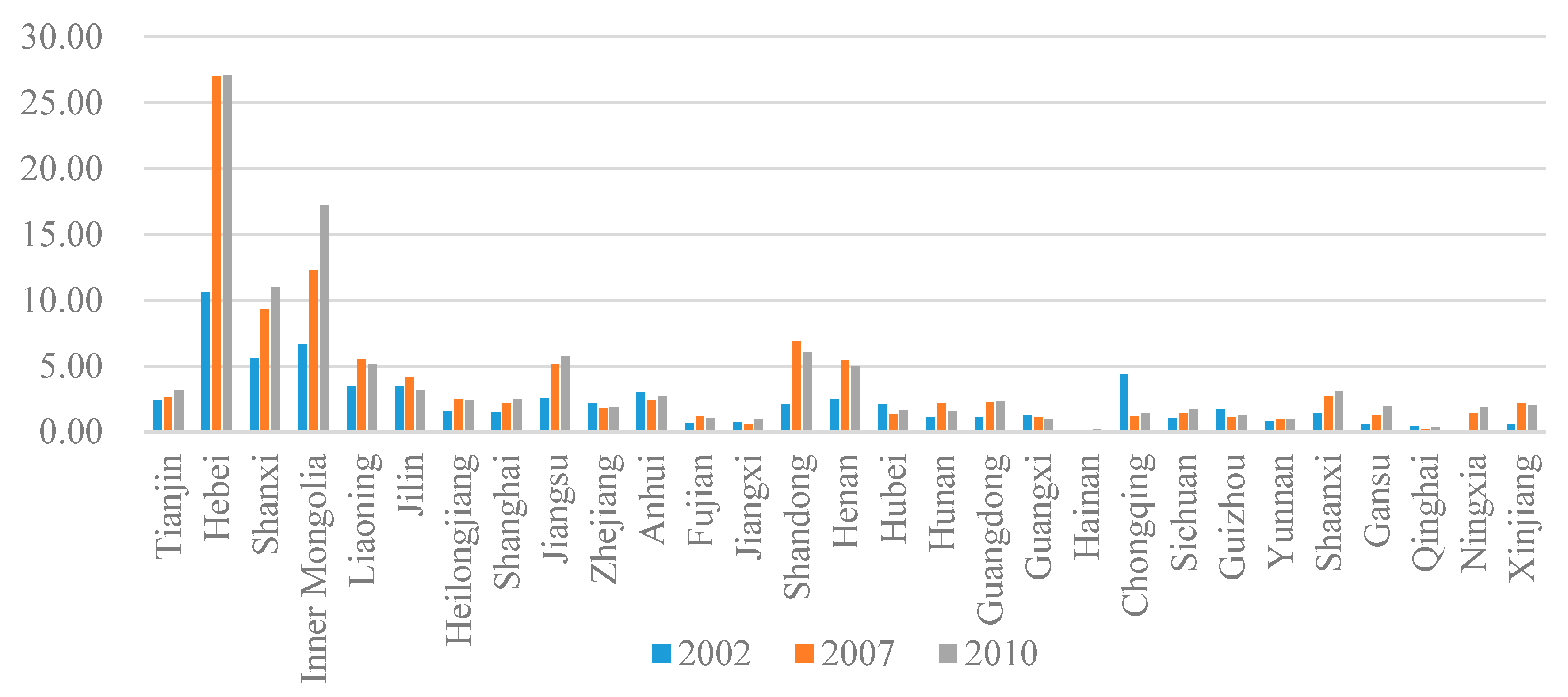
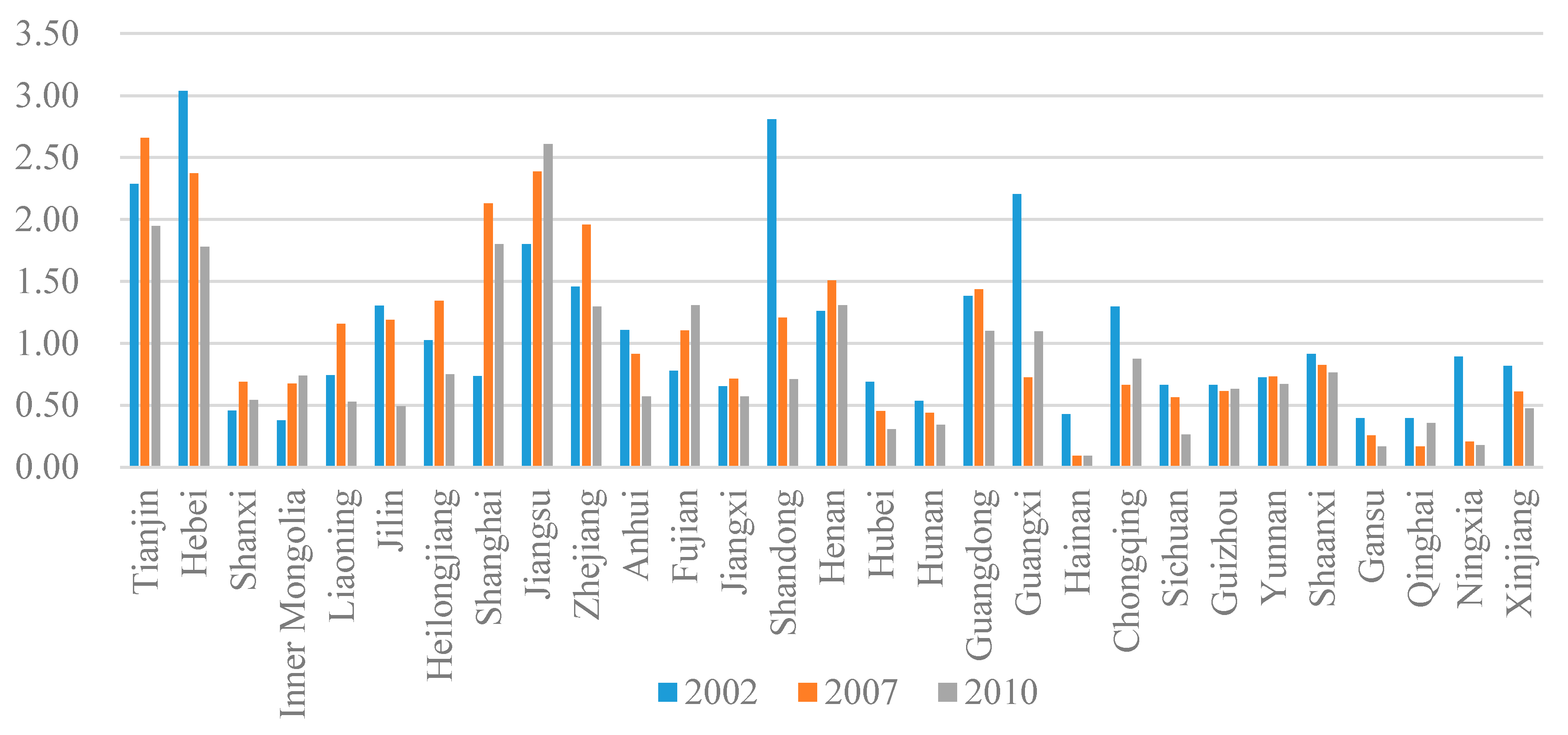
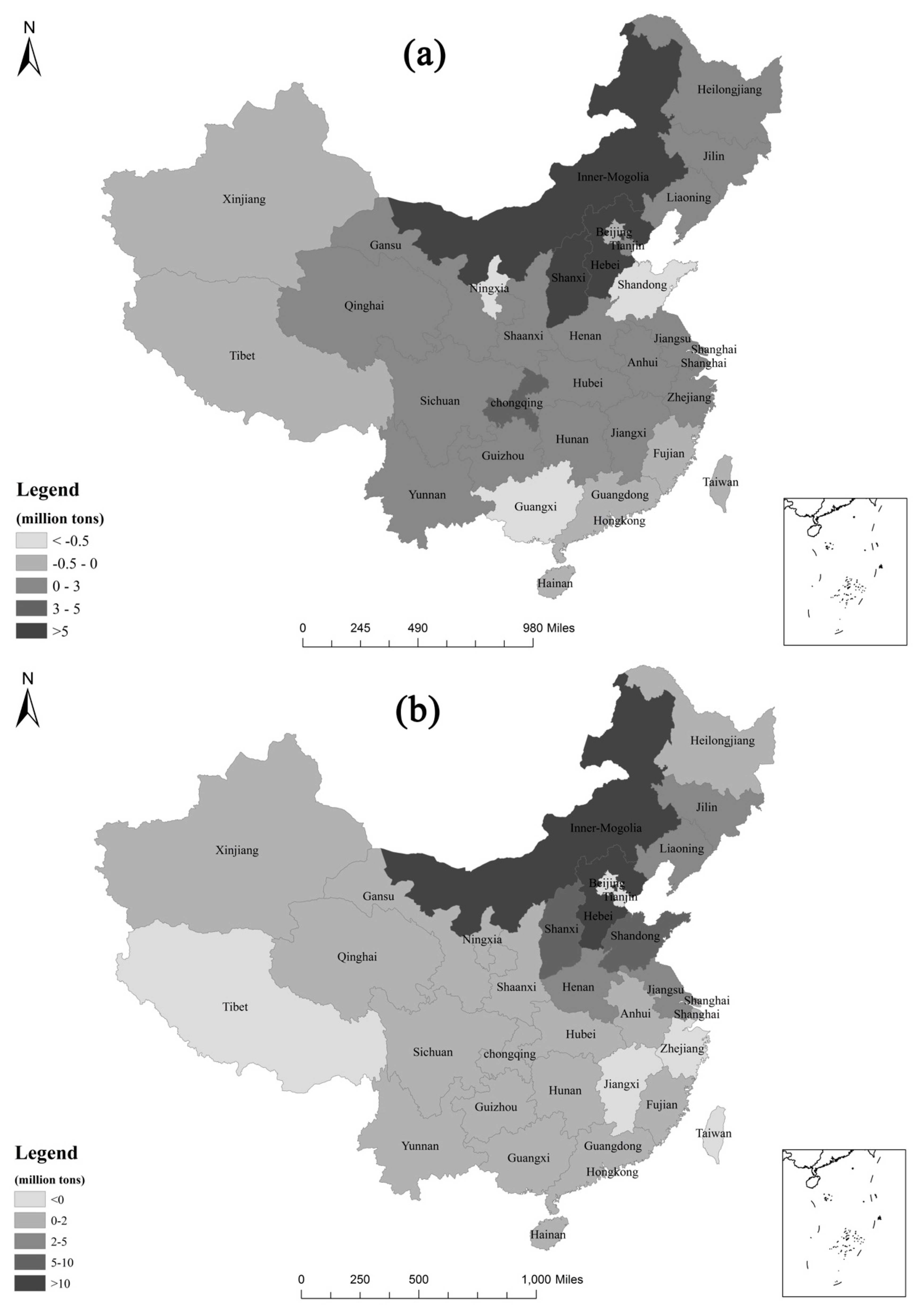
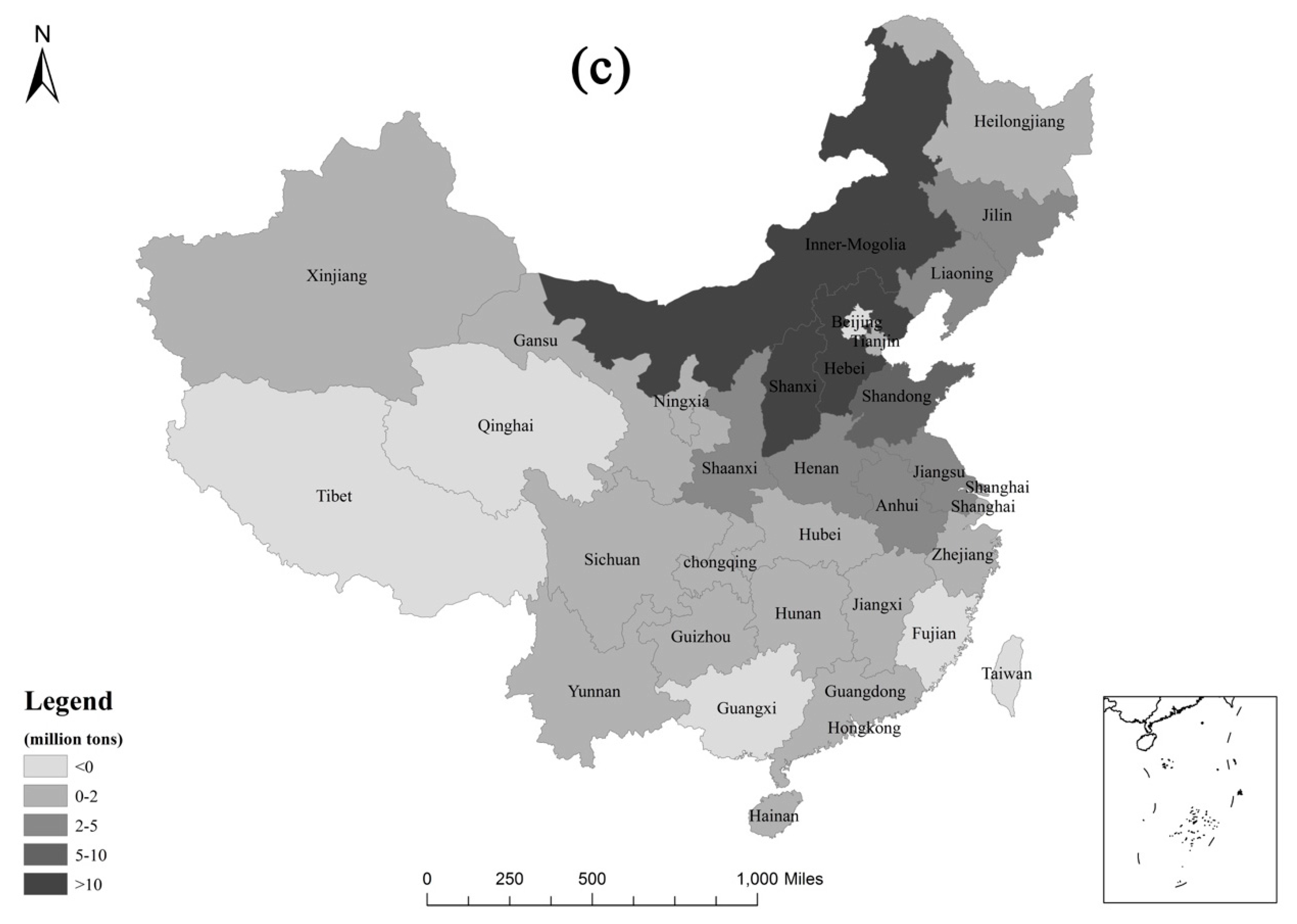
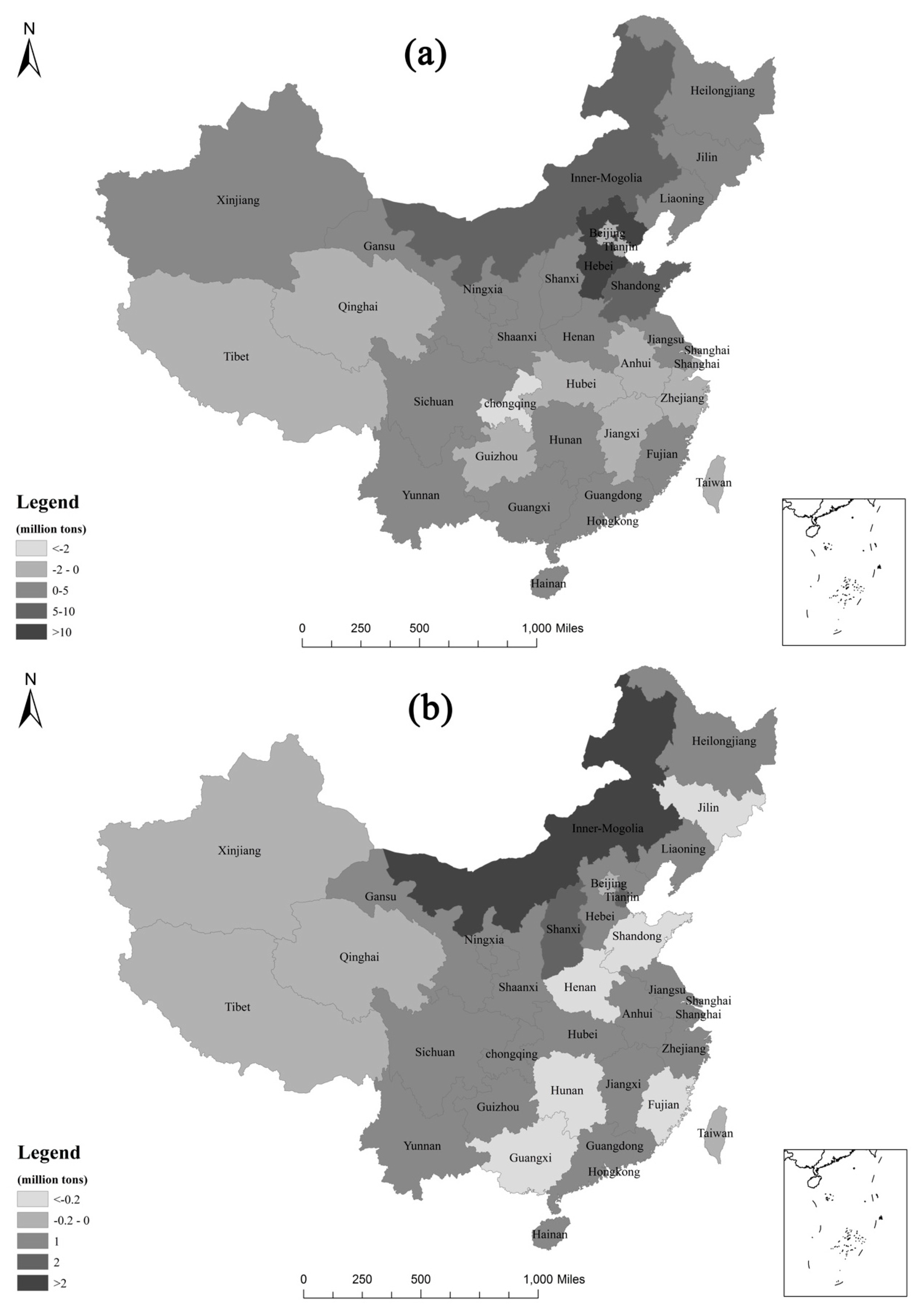
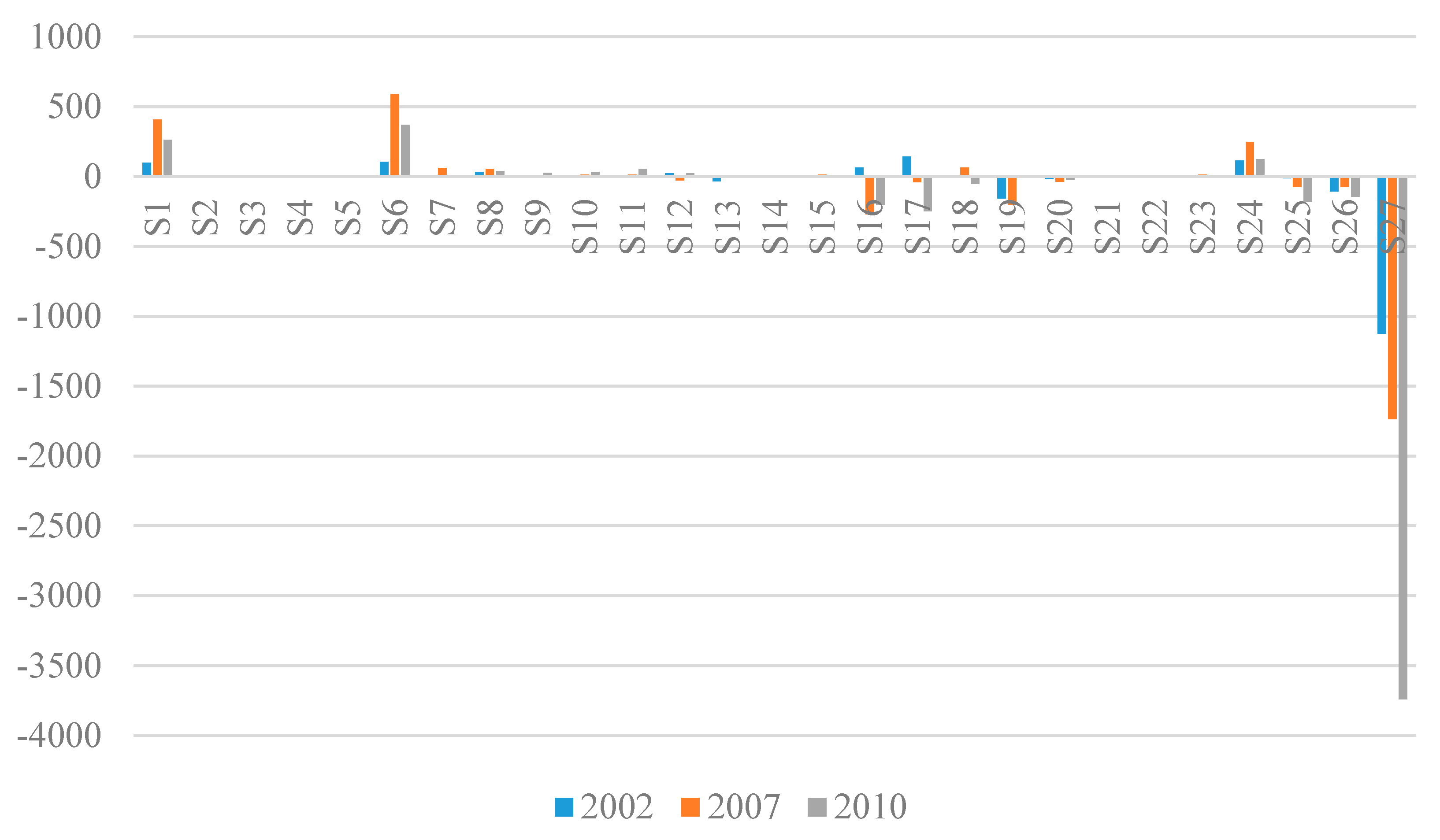
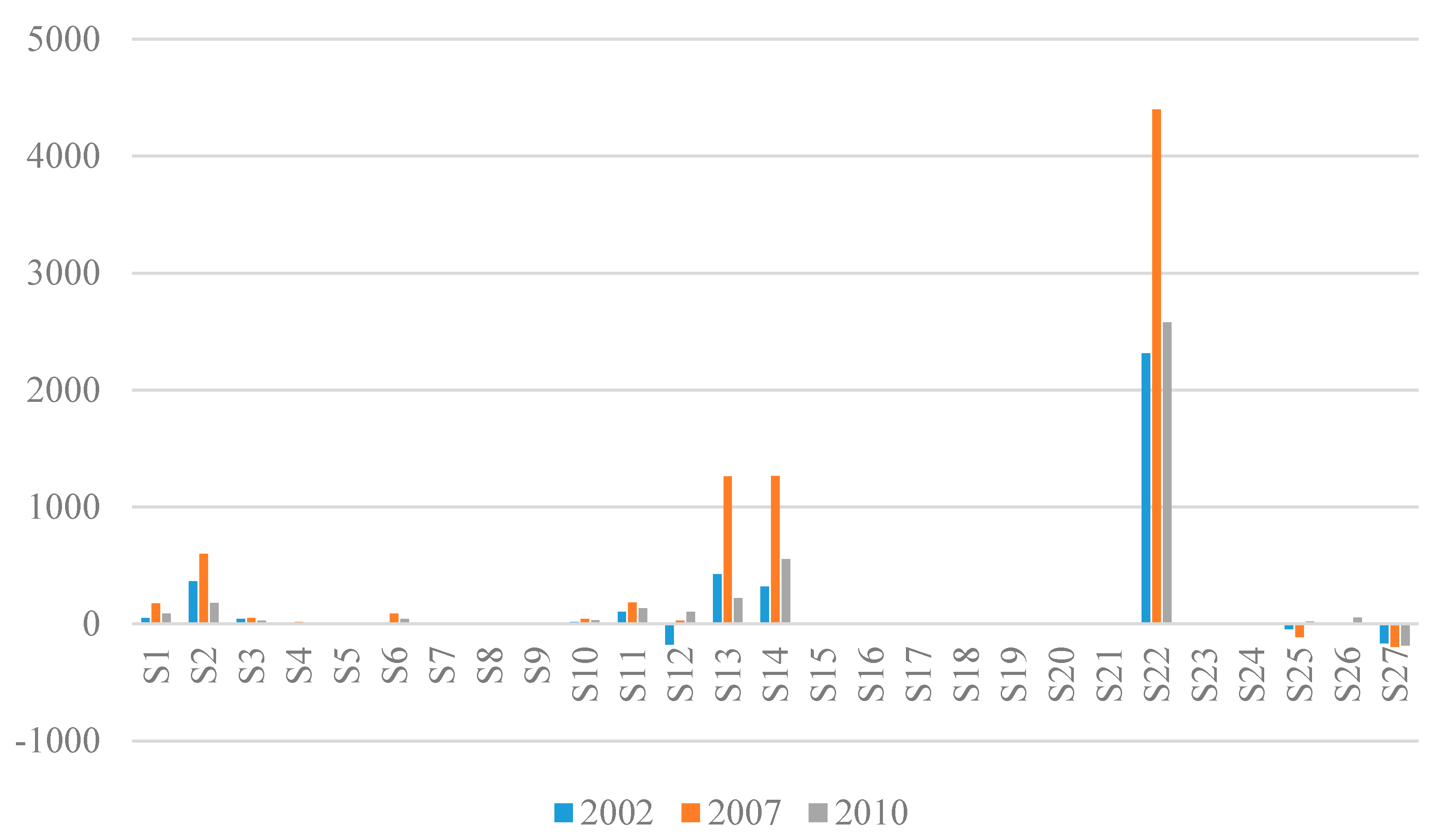
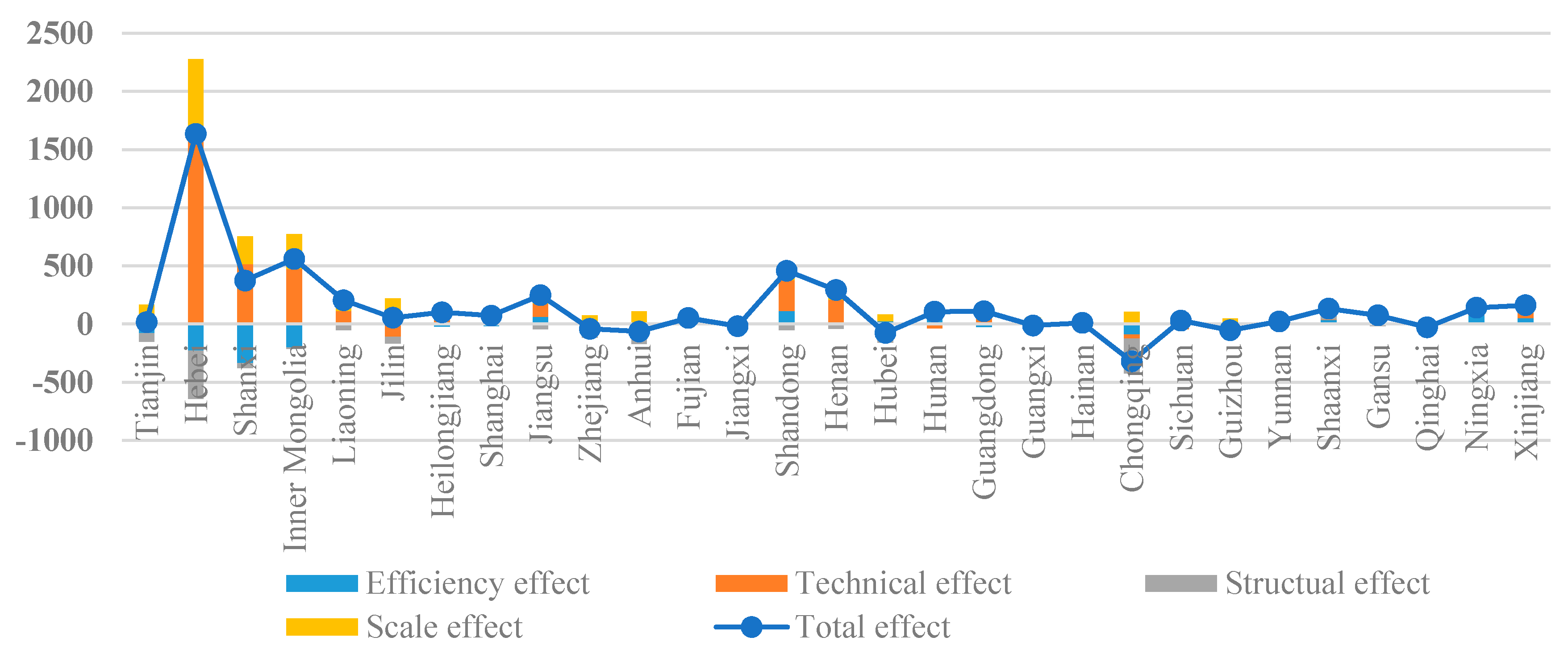
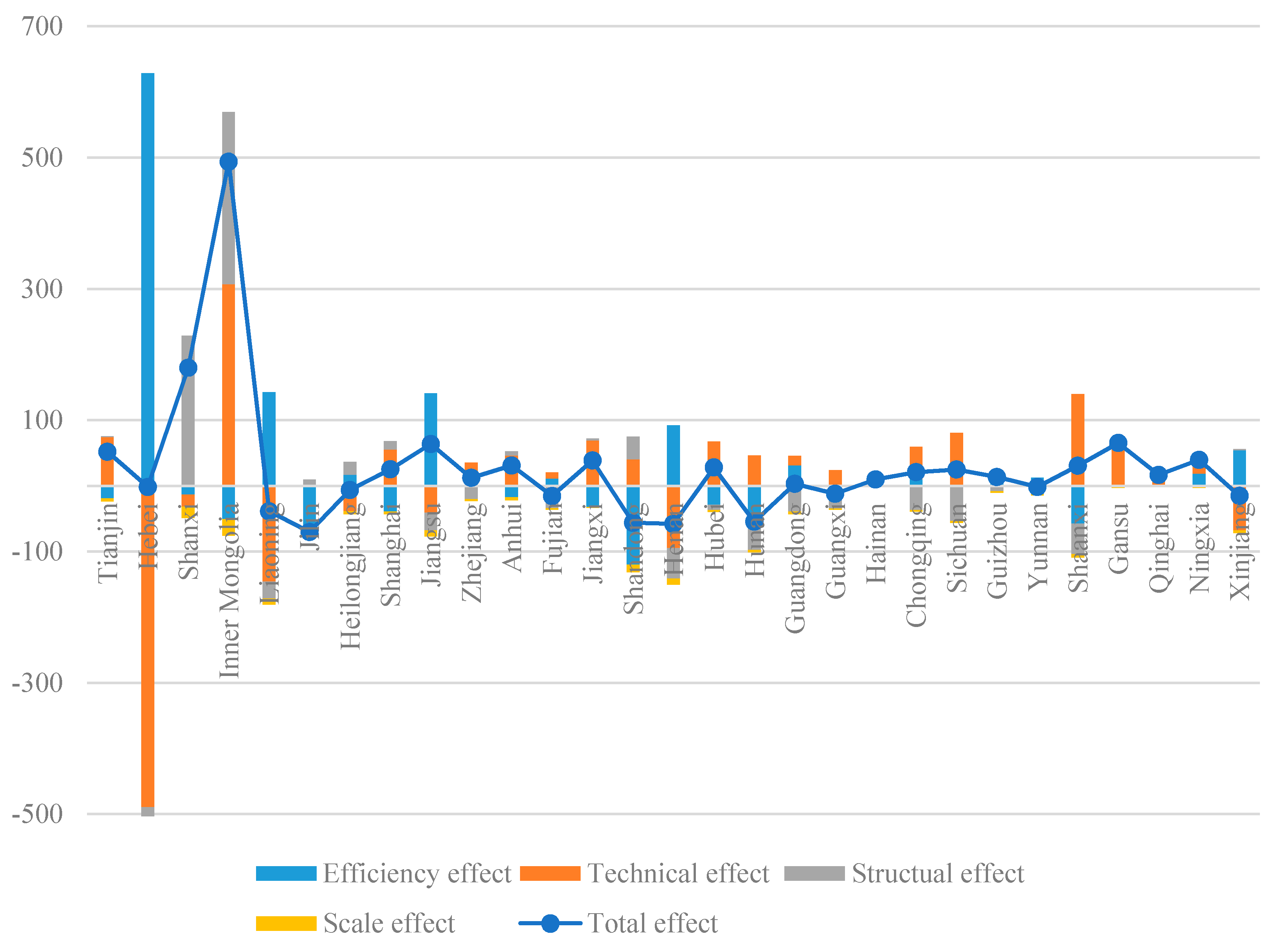
| No. | Administrative Region | No. | Administrative Region |
|---|---|---|---|
| 1 | Beijing | 16 | Henan |
| 2 | Tianjin | 17 | Hubei |
| 3 | Hebei | 18 | Hunan |
| 4 | Shanxi | 19 | Guangdong |
| 5 | Inner Mongolia | 20 | Guangxi |
| 6 | Liaoning | 21 | Hainan |
| 7 | Jilin | 22 | Chongqing |
| 8 | Heilongjiang | 23 | Sichuan |
| 9 | Shanghai | 24 | Guizhou |
| 10 | Jiangsu | 25 | Yunnan |
| 11 | Zhejiang | 26 | Shaanxi |
| 12 | Anhui | 27 | Gansu |
| 13 | Fujian | 28 | Qinghai |
| 14 | Jiangxi | 29 | Ningxia |
| 15 | Shandong | 30 | Xinjiang |
| Symbol | 27-Sector Merge | 42-Sector Data (CEADs Database) | 30-Sector Data (MRIO Table) |
|---|---|---|---|
| S1 | Farming, Forestry, Animal Husbandry, Fishing and Water conservation | Farming, Forestry, Animal Husbandry, Fishery and Water conservancy | Farming, Forestry, Animal Husbandry, Fishing and Water conservation |
| S2 | Coal mining and pressing | Coal mining and dressing | Coal mining and pressing |
| S3 | Petroleum and Natural gas extraction | Petroleum and Natural gas extraction | Petroleum and Natural gas extraction |
| S4 | Metals mining and pressing | Ferrous metals mining and dressing; nonferrous metals mining and dressing | Metals mining and pressing |
| S5 | Nonferrous metals and Other minerals mining and pressing | Nonferrous metals mining and dressing; Other minerals mining and dressing | Nonferrous metals mining and pressing |
| S6 | Food manufacturing and Tobacco processing | Food processing; Food production; Beverage production; Tobacco processing | Food manufacturing and Tobacco processing |
| S7 | Textile industry | Textile industry | Textile industry |
| S8 | Textile, Clothing, Shoes, Hats, Leather, Feather and Down products | Garments and Other Fiber Products; Leather, Furs, Down and related products | Textile, Clothing, Shoes, Hats, Leather, Feather and Down products |
| S9 | Wood processing and Furniture manufacturing | Timber processing, Bamboo, Cane, Palm fiber & Straw products; Furniture manufacturing | Wood processing and Furniture manufacturing |
| S10 | Paper printing, Stationery, Sports goods manufacturing | Papermaking and paper products; Printing and record medium reproduction; Cultural, Educational and Sports articles | Paper printing, Stationery, Sports goods manufacturing |
| S11 | Petroleum processing, coking and nuclear fuel processing | Petroleum processing and coking | Petroleum processing, coking and nuclear fuel processing |
| S12 | Chemical industry | Raw chemical materials and chemical products; Medical and pharmaceutical products; Chemical fiber; Rubber products; Plastic products | Chemical industry |
| S13 | Nonmetal mineral products | Nonmetal mineral Products | Nonmetallic mineral products industry |
| S14 | Smelting and pressing of ferrous and nonferrous metals | Smelting and pressing of ferrous metals; Smelting and pressing of nonferrous metals | Smelting and pressing of ferrous metals |
| S15 | Metal products | Metal products | Metal products |
| S16 | General and special equipment manufacturing | Ordinary machinery; Equipment for special purposes | General and special equipment manufacturing |
| S17 | Transportation equipment manufacturing industry | Transportation equipment | Transportation equipment manufacturing industry |
| S18 | Electrical equipment and machinery | Electric equipment and machinery | Electrical equipment and machinery |
| S19 | Communications equipment, computers and other electronic equipment manufacturing industry | Electronic and telecommunications Equipment | Communications equipment, computers and other electronic equipment manufacturing industry |
| S20 | Instruments, Meters, Cultural and Office machinery | Instruments, Meters, Cultural and Office machinery | Instruments, Meters, Cultural and Office machinery |
| S21 | Other manufacturing industries | Other manufacturing industry | Other manufacturing industries |
| S22 | Production and supply of electricity and heat | Production and supply of electric power, Steam and hot water | Production and supply of electricity and heat |
| S23 | Production and supply of gas and water | Production and supply of gas; Production and supply of tap water | Production and supply of gas and water |
| S24 | Construction | Construction | Construction |
| S25 | Transportation and storage | Transportation, Storage, Post and Telecommunication services | Transportation and storage |
| S26 | Wholesale, and Retail trade services | Wholesale, and Retail trade services | Wholesale, and Retail trade services |
| S27 | Accommodations and catering | Others services | Accommodations and catering |
| 2002 | 2007 | 2010 | |
|---|---|---|---|
| Trade volume (billion yuan) | −772.86 | 234.60 | 822.26 |
| Portion of annual production value of Beijing (%) | −8.05 | 1.76 | 6.26 |
| Embodied carbon(million tons) | 33.58 | 78.93 | 92.08 |
| Portion of annual CO2 emissions, for Beijing (%) | 46.91 | 86.42 | 103.14 |
| Dependence degree (%) | 29.63 | 53.54 | 56.51 |
| 2002–2007 | 2007–2010 | 2002–2010 | |
|---|---|---|---|
| production-based CO2 emissions inte (million tons) | 19.76 | −2.07 | 17.69 |
| consumption-based CO2 emissions (million tons) | 34.11 | 15.50 | 49.61 |
| Change rate of production-based CO2 emissions intenstiy (%/year) | −49.57 | −46.26 | −77.19 |
| Change rate of consumption-based CO2 emissions intensity (%/year) | −40.53 | 26.59 | 54.38 |
| 2002 | 2007 | 2010 | ||||
|---|---|---|---|---|---|---|
| Sector | Beijing | Non-Beijing | Beijing | Non-Beijing | Beijing | Non-Beijing |
| S1 | 0.22 ▲ | 0.17 | 0.34 ▲ | 0.21 | 0.35 ▲ | 0.21 |
| S2 | 0.01 | 1.95 | 0.01 | 2.11 | 0.00 | 1.34 |
| S3 | 0.00 | 0.36 | 0.90 ▲ | 0.45 | 0.23 | 0.31 |
| S4 | 0.53 ▲ | 0.27 | 0.31 ▲ | 0.23 | 0.02 | 0.21 |
| S5 | 0.88 ▲ | 0.24 | 0.61 ▲ | 0.27 | 0.78 ▲ | 0.22 |
| S6 | 0.06 | 0.06 | 0.07 | 0.10 | 0.05 | 0.09 |
| S7 | 0.04 | 0.06 | 0.06 | 0.09 | 0.06 | 0.09 |
| S8 | 0.04 ▲ | 0.02 | 0.06 ▲ | 0.03 | 0.05 ▲ | 0.03 |
| S9 | 0.03 | 0.05 | 0.04 | 0.06 | 0.03 | 0.06 |
| S10 | 0.05 | 0.12 | 0.06 | 0.22 | 0.06 | 0.20 |
| S11 | 0.32 | 2.57 | 0.47 | 1.79 | 0.41 | 1.63 |
| S12 | 0.50 | 0.24 | 0.39 ▲ | 0.35 | 0.27 | 0.34 |
| S13 | 1.21 | 1.71 | 1.37 | 3.23 | 1.09 | 3.39 |
| S14 | 2.74 ▲ | 1.65 | 1.22 | 1.46 | 4.01 ▲ | 2.04 |
| S15 | 0.03 | 0.06 | 0.03 | 0.12 | 0.02 | 0.10 |
| S16 | 0.05 | 0.07 | 0.03 | 0.11 | 0.03 | 0.09 |
| S17 | 0.04 | 0.05 | 0.02 | 0.06 | 0.01 | 0.05 |
| S18 | 0.01 | 0.03 | 0.01 | 0.04 | 0.01 | 0.03 |
| S19 | 0.00 | 0.42 | 0.00 | 0.14 | 0.00 | 0.09 |
| S20 | 0.01 | 0.02 | 0.01 | 0.03 | 0.01 | 0.03 |
| S21 | 0.21 ▲ | 0.04 | 0.22 | 0.09 | 0.09 ▲ | 0.08 |
| S22 | 11.63 ▲ | 9.81 | 2.56 | 9.69 | 1.74 | 9.59 |
| S23 | 0.02 | 0.22 | 0.07 | 0.39 | 0.03 | 0.34 |
| S24 | 0.03 | 0.05 | 0.05 | 0.06 | 0.06 | 0.06 |
| S25 | 0.74 ▲ | 0.58 | 0.74 | 1.12 | 0.71 | 1.23 |
| S26 | 0.05 | 0.10 | 0.14 | 0.20 | 0.06 | 0.22 |
| S27 | 0.05 | 0.06 | 0.06 | 0.07 | 0.04 | 0.09 |
| Average | 0.72 | 0.78 | 0.36 | 0.84 | 0.38 | 0.82 |
| Embodied CO2 Emissions | 2002 | 2007 | 2010 | ||||||
|---|---|---|---|---|---|---|---|---|---|
| Virtual | Actual | Increase | Virtual | Actual | Increase | Virtual | Actual | Increase | |
| Net influx | 16.83 | 38.66 | 21.84 | 30.23 | 78.94 | 48.70 | 56.21 | 92.08 | 35.87 |
| Proportion (%) | 21.10 | 48.49 | 27.38 | 44.14 | 115.24 | 71.11 | 79.34 | 129.96 | 50.62 |
| Period | Efficiency Effect | Technical Effect | Composition Effect | Scale Effect | Total Effect |
|---|---|---|---|---|---|
| 2002–2010 | −1.68 | 38.70 | −13.72 | 27.36 | 50.66 |
| Proportion | −3.31% | 76.39% | −27.08% | 54.00% | 100% |
| 2002–2007 | −3.3518 | 30.8844 | −12.7620 | 27.7070 | 42.4777 |
| Proportion | −7.89% | 72.71% | −30.04% | 65.23% | 100.00% |
| 2007–2010 | 7.0255 | 2.4654 | 0.6224 | −1.9323 | 8.1809 |
| Proportion | 85.88% | 30.14% | 7.61% | −23.62% | 100.00% |
© 2017 by the authors. Licensee MDPI, Basel, Switzerland. This article is an open access article distributed under the terms and conditions of the Creative Commons Attribution (CC BY) license (http://creativecommons.org/licenses/by/4.0/).
Share and Cite
Wen, W.; Wang, Q. Are Developed Regions in China Achieving Their CO2 Emissions Reduction Targets on Their Own?—Case of Beijing. Energies 2017, 10, 1952. https://doi.org/10.3390/en10121952
Wen W, Wang Q. Are Developed Regions in China Achieving Their CO2 Emissions Reduction Targets on Their Own?—Case of Beijing. Energies. 2017; 10(12):1952. https://doi.org/10.3390/en10121952
Chicago/Turabian StyleWen, Wen, and Qi Wang. 2017. "Are Developed Regions in China Achieving Their CO2 Emissions Reduction Targets on Their Own?—Case of Beijing" Energies 10, no. 12: 1952. https://doi.org/10.3390/en10121952
APA StyleWen, W., & Wang, Q. (2017). Are Developed Regions in China Achieving Their CO2 Emissions Reduction Targets on Their Own?—Case of Beijing. Energies, 10(12), 1952. https://doi.org/10.3390/en10121952




